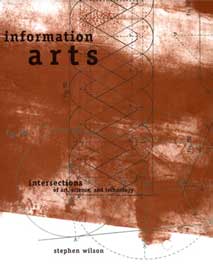monday :: december 3, 2001
.
:: intersections of art, science, and technology
Steve Wilson presents their book "Information Arts: Intersections of Art, Science, and Technology", published in the Leonardo Book Series by MIT Press. Offers one of the only comprehensive international survey of artists working at the frontiers of scientific inquiry and emerging technologies, who incorporate concepts and research from mathematics, the physical sciences, biology, kinetics, telecommunications, and experimental digital systems such as artificial intelligence and ubiquitous computing. And also provides lists of resources including organizations, publications, conferences, museums, research centers, and web sites. Its goal is to describe this art, explore its theoretical rationales, and alert readers to possible future directions.
One of the only sources available that reviews cutting edge techno-scientific research in a way accessible to those without extensive technical backgrounds. "We must learn to appreciate and produce science and technology just as we do literature, music, and the arts. They are part of the cultural core of our era and must become part of general discourse in a profound way." Years ago, C. P. Snow wrote about the "two cultures" of science and the humanities; these developments may finally help to change the outlook of those who view science and technology as separate from the general culture. Literacy for our techno times.
Leonardo and 0:one, the Art & Technology Network, will host the release celebration. The event, at the Silicon Valley MicroSoft campus, include a book signing by Steve Wilson and presentations by a number of the artists that are discussed in the book.
related context
> corner
of art place and tech lane
by chloe veltman. wired, december 4, 2001
